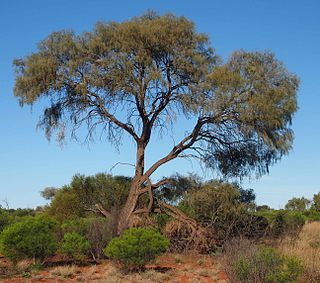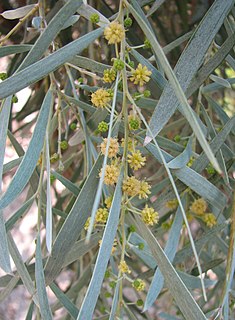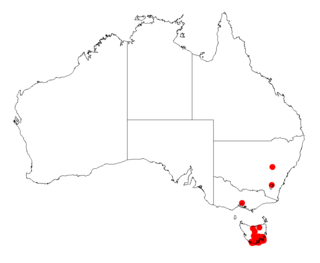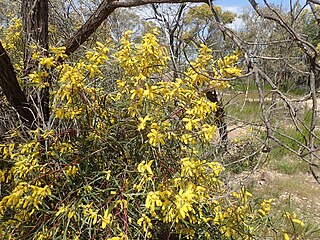Wattle or wattles may refer to:

The Hunter Region, also commonly known as the Hunter Valley, is a region of New South Wales, Australia, extending from approximately 120 km (75 mi) to 310 km (193 mi) north of Sydney. It contains the Hunter River and its tributaries with highland areas to the north and south. Situated at the northern end of the Sydney Basin bioregion, the Hunter Valley is one of the largest river valleys on the NSW coast, and is most commonly known for its wineries and coal industry.

Acacia aneura, commonly known as mulga or true mulga, is a shrub or small tree native to arid outback areas of Australia. It is the dominant tree in the habitat to which it gives its name (mulga) that occurs across much of inland Australia. Specific regions have been designated the Western Australian mulga shrublands in Western Australia and Mulga Lands in Queensland.
George Don was a Scottish botanist and plant collector.

Acacia papyrocarpa, commonly known as western myall, is a tree in the family Fabaceae native to arid areas of central and western Australia.

Acacia, commonly known as the wattles or acacias, is a large genus of shrubs and trees in the subfamily Mimosoideae of the pea family Fabaceae. Initially, it comprised a group of plant species native to Angola and Australasia. The genus name is New Latin, borrowed from the Greek ἀκακία, a term used by Dioscorides for a preparation extracted from the leaves and fruit pods of Vachellia nilotica, the original type of the genus. In his Pinax (1623), Gaspard Bauhin mentioned the Greek ἀκακία from Dioscorides as the origin of the Latin name.

Acacia estrophiolata, commonly known as ironwood, southern ironwood, desert ironwood or utjanypa, is a tree native to Central Australia.

Black wattle is the common name for a number of species of trees that are native to Australia, as listed below:

Acacia pendula, commonly known as the weeping myall, true myall, myall, silver-leaf boree, boree, and nilyah, is a species of wattle, which is native to Australia. The 1889 book The Useful Native Plants of Australia records that common names included "Weeping Myall", "True Myall", and Indigenous people of western areas of New South Wales and Queensland referred to the plant as "Boree" and "Balaar".

Acacia stenophylla is a species of Acacia commonly referred to as the shoestring acacia. It is an evergreen tree in the family Fabaceae native to Australia. It is not considered rare or endangered.

Acacia binervia, commonly known as the coast myall, is a wattle native to New South Wales and Victoria. It can grow as a shrub or as a tree reaching 16 m in height. This plant is reportedly toxic to livestock as the foliage (phyllodes) contain a glucoside which can produce hydrogen cyanide if cut.

Acacia riceana, commonly known as Rice's wattle, is a small, fast-growing, evergreen shrub to small tree in the legume family endemic to the southeast corner of Tasmania.

Acacia calcicola is a shrub or tree of the genus Acacia and the subgenus Plurinerves that is native to parts of central Australia. Common names for this species include; shrubby wattle, shrubby mulga, myall-gidgee, northern myall and grey myall. Indigenous Australians the Pitjantjatjara peoples know the tree as ikatuka, the Warlpiri know it as jirlarti and the Arrernte know it as irrakwetye.

Acacia lineolata, commonly known as dwarf myall, is a shrub of the genus Acacia and the subgenus Plurinerves that is endemic to an area of south western Australia.
Myall Creek is a locality split between the local government areas of Inverell Shire and the Gwydir Shire in New South Wales, Australia. In the 2016 census, Myall Creek had a population of 38 people.

Acacia atrox, commonly known as Myall Creek wattle, is a shrub belonging to the genus Acacia and the subgenus Phyllodineae that is endemic to a small area in New South Wales.

Acacia doratoxylon, commonly known as currawang, lancewood, spearwood or coast myall, is a shrub or tree belonging to the genus Acacia and the subgenus Juliflorae that is native to eastern and south eastern Australia.
The Weeping Myall Woodlands is an endangered ecological community, under the EPBC Act of the Commonwealth of Australia. It is found in inland Queensland and inland New South Wales, on alluvial plains west of the Great Dividing Range. It takes its name from Acacia pendula, the weeping myall.













